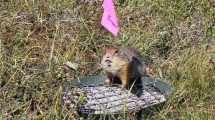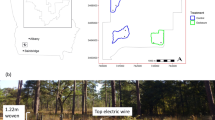Abstract
When social animals cache food close to their burrow, the potential for an audience member to observe the event is significantly increased. As a consequence, in order to reduce theft it may be advantageous for animals to be sensitive to certain audience cues, such as whether they are attentive or not to the cache event. In this study, observations were made on three groups of Cape ground squirrels (Xerus inauris) in their natural habitat when they cached provisioned food items. When individuals cached within 10 m of conspecifics, we recorded the attentiveness (i.e. whether any audience members were orientated towards the cacher, had direct line of site and were not engaged in other activities) and identity of audience members. Overall, there was a preference to cache when audience members were inattentive rather than attentive. Additionally, we found rank effects related to cache avoidance whereby high-ranked individuals showed less avoidance to cache when audience members were attentive compared to medium- and low-ranked individuals. We suggest this audience sensitivity may have evolved in response to the difference in competitive ability amongst the ranks in how successful individuals are at winning foraging competitions. This study demonstrates that Cape ground squirrels have the ability to not only monitor the presence or absence of conspecifics but also discriminate individuals on the basis of their attentive state.



Similar content being viewed by others
References
Andersson M, Krebs JR (1978) On the evolution of hoarding behaviour. Anim Behav 26:707–711
Balme G, Hunter L, Slotow R (2007) Feeding habitat selection by hunting leopards Panthera pardus in a woodland savanna: prey catchability versus abundance. Anim Behav 74:589–598
Bates D, Maechler M, Bolker B, Walker S (2014) Lme4: linear mixed-effects models using Eigen and S4. R package version 1.1–7, http://CRAN.R-project.org/package=lme4
Bednekoff P, Balda R (1996a) Social caching and observational spatial memory in pinyon jays. Behaviour 133:807–826
Bednekoff P, Balda R (1996b) Observational spatial memory in Clark’s nutcrackers and Mexican jays. Anim Behav 52:833–839
Brodin A, Urhan AU (2015) Sex differences in learning ability in a common songbird, the great tit—females are better observational learners than males. Behav Ecol Sociobiol 69:237–241
Brotherton PNM, Clutton-Brock TH, O’Riain MJ, Gaynor D, Sharpe L, Kansky R, McIlrath GM (2001) Offspring food allocation by parents and helpers in a cooperative mammal. Behav Ecol 12:590–599
Bugnyar T, Heinrich B (2005) Ravens, Corvus corax, differentiate between knowledgeable and ignorant competitors. Proc R Soc Lond B 272:1641–1646
Bugnyar T, Kotrschal K (2002) Observational learning and the raiding of food caches in ravens, Corvus corax : is it “tactical” deception? Anim Behav 64:185–195
Clarke MF, Kramer DL (1994) Scatter-hoarding by a larder-hoarding rodent: intraspecific variation in the hoarding behaviour of the eastern chipmunk, Tamias striatus. Anim Behav 48:299–308
Clayton NS, Dally JM, Emery NJ (2007) Social cognition by food-caching corvids. The western scrub-jay as a natural psychologist. Philos Trans R Soc B 362:507–522
Colegrave N, Ruxton GD (2003) Confidence intervals are a more useful complement to nonsignificant tests than are power calculations. Behav Ecol 14:446–447. doi:10.1093/beheco/14.3.446
Crawley MJ (2007) The R book. Wiley, New York
Dally JM, Emery NJ, Clayton NS (2004) Cache protection strategies by western scrub-jays (Aphelocoma californica): hiding food in the shade. Proc R Soc Lond B 271:387–390
Dally J, Clayton N, Emery N (2005) The social suppression of caching in western scrub-jays (Aphelocoma californica). Behaviour 142:961–977
Dally JM, Clayton NS, Emery NJ (2006) The behaviour and evolution of cache protection and pilferage. Anim Behav 72:13–23
de Vries H, Stevens JMG, Vervaecke H (2006) Measuring and testing the steepness of dominance hierarchies. Anim Behav 71:585–592
Di Bitetti MS, Janson CH (2001) Social foraging and the finder’s share in capuchin monkeys, Cebus apella. Anim Behav 62:47–56
Emery NJ, Clayton NS (2001) Effects of experience and social context on prospective caching strategies by scrub jays. Nature 414:443–446
Emery NJ, Clayton NS (2004) The mentality of crows: convergent evolution of intelligence in corvids and apes. Science 306:1903–1907
Emery NJ, Dally JM, Clayton NS (2004) Western scrub-jays (Aphelocoma californica) use cognitive strategies to protect their caches from thieving conspecifics. Anim Cogn 7:37–43
Heinrich B, Pepper JW (1998) Influence of competitors on caching behaviour in the common raven, Corvus corax. Anim Behav 56:1083–1090
Hillegass MA, Waterman JM, Roth JD (2008) The influence of sex and sociality on parasite loads in an African ground squirrel. Behav Ecol. doi:10.1093/beheco/arn070
Hopewell LJ, Leaver LA (2008) Evidence of social influences on cache-making by grey squirrels (Sciurus carolinensis). Ethol 114:1061–1068
Hothorn T, Bretz F, Westfall P (2008) Simultaneous inference in general parametric models. Biom J 50:346–363
Jenkins SH (2011) Sex differences in repeatability of food-hoarding behaviour of kangaroo rats. Anim Behav 81:1155–1162
Lahti K, Rytkonen S (1996) Presence of conspecifics, time of day and age affect willow tit food hoarding. Anim Behav 52:631–636
Lahti K, Koivula K, Rytkonen S, Mustonen T, Welling P, Pravosudov VV, Orell M (1998) Social influences on food caching in willow tits: a field experiment. Behav Ecol 9:122–129
Leaver L, Hopewell L, Caldwell C, Mallarky L (2007) Audience effects on food caching in grey squirrels (Sciurus carolinensis): evidence for pilferage avoidance strategies. Anim Cogn 10:23–27
Levine M, Ensom MH (2001) Post hoc power analysis: an idea whose time has passed? Pharmacotherapy 21:405–409
Miklósi Á, Haller J, Csányi V (1995) The influence of opponent and outcome—related memory on repeated aggressive encounters in the paradise fish (Macropodus opercularis). Biol Bull 188:83–88
Pravosudov V (2008) Mountain chickadees discriminate between potential cache pilferers and non-pilferers. Proc R Soc Lond B 275:55–61
Pravosudov VV, Grubb JR (1997) Management of fat reserves and food caches in tufted titmice (Parus bicolor) in relation to unpredictable food supply. Behav Ecol 8:332–339
Pravosudov V, Lucas J (2000) The effect of social dominance on fattening and food-caching behaviour in Carolina chickadees, Poecile carolinensis. Anim Behav 60:483–493
Preston SD, Jacobs LF (2001) Conspecific pilferage but not presence affects Merriam’s kangaroo rat cache strategy. Behav Ecol 12:517–523
Preston SD, Jacobs LF (2009) Mechanisms of cache decision making in fox squirrels (Sciurus niger). J Mamm 90:787–795
R Development Core Team (2008) R: a language and environment for statistical computing. R Foundation for Statistical Computing, Vienna, Austria. ISBN 3-900051-07-0. http://www.R-project.org/
Russell AF, Clutton-Brock TH, Brotherton PNM, Sharpe LL, McIlrath GM, Dalerum FD, Cameron EZ, Barnard JA (2002) Factors affecting pup growth and survival in cooperatively breeding meerkats Suricata suricatta. J Anim Ecol 71:700–709
Schmidt K, Ostfeld RS (2008) Eavesdropping squirrels reduce their future value of food under the perceived presence of cache robbers. Am Nat 171:386–393
Smale L, Frank LR, Holekamp KE (1993) Ontogeny of dominance in free-living spotted hyaenas: juvenile rank relations with adult females and immigrant males. Anim Behav 46:467–477
Steele MA, Halkin SL, Smallwood PD, McKenna TJ, Mitsopoulos K, Beam M (2008) Cache protection strategies of a scatter-hoarding rodent: do tree squirrels engage in behavioural deception? Anim Behav 75:705–714
Steer J, Burns K (2008) Seasonal variation in male–female competition, cooperation and selfish hoarding in a monogamous songbird. Behav Ecol Sociobiol 62:1175–1183
Thom JM, Clayton NS (2013) Re-caching by Western scrub-jays (Aphelocoma californica) cannot be attributed to stress. PLoS One. doi:10.1371/journal.pone.0052936
Tshikae BP, Davis ALV, Scholtz CH (2013) Does an aridity and trophic resource gradient drive patterns of dung beetle food selection across the Botswana Kalahari? Ecol Entomol 38:83–95
van der Vaart E, Verbrugge R, Hemelrijk CK (2012) Corvid re-caching without ‘theory of mind’: a model. PLoS One 7(3):e32904. doi:10.1371/journal.pone.0032904
Vander Wall SB (1990) Food hoarding in animals. University of Chicago Press, Chicago
Waterman JM (1995) The social organization of the Cape ground squirrel. Ethol 101:130–147
Waterman JM (1996) Reproductive biology of a tropical, non-hibernating ground squirrel. J Mamm 77:134–146
Waterman JM (1998) Mating tactics of male Cape ground squirrels, Xerus inauris: consequences of year-round breeding. Anim Behav 56:459–466
Wittig RM, Boesch C (2003) Food competition and linear dominance hierarchy among female chimpanzees of the Tai National Park. Int J Primatol 24:847–867
Yi-Ting L, Hsu Y (2011) Prior contest experience exerts a long-term influence on subsequent winner and loser effects. Front Zool 8:28–40
Zhang H, Gao H, Yang Z, Wang Z, Luo Y, Zhang Z (2014a) Effects of interspecific competition on food hoarding and pilferage in two sympatric rodents. Behaviour 151:1579–1596
Zhang HM, Steele MA, Zhang ZB, Wang W, Wang Y (2014b) Rapid sequestration and recaching by a scatter-hoarding rodent (Sciurotamias davidianus). J Mamm 95:480–490
Acknowledgments
We would like to thank Tim Clutton-Brock and the Kalahari Research Trust for support and access to work on the Kuruman River Reserve. This study would not have been possible without the logistical support from Dave Gaynor. We would like to thank the volunteers on the squirrel project for their help collecting the ad libitum data on the squirrels. Thanks must also be extended to Simon Townsend and Nicola Harrison for helpful comments on the manuscript. The maintenance of the study population and collection of basic data was financed by the Universities of Cambridge and Zurich. JS and MBM were both funded by the University of Zurich.
Author information
Authors and Affiliations
Corresponding author
Ethics declarations
Ethical standards
All applicable international, national and/or institutional guidelines for the care and use of animals were followed. All procedures performed in studies involving animals were in accordance with the ethical standards of the institution [University of Pretoria Animal Ethics Committee (S4532-13) and in the approved permit (number: ECO16-13)] at which the studies were conducted.
Conflict of interest
The authors declare that they have no conflict of interest.
Rights and permissions
About this article
Cite this article
Samson, J., Manser, M.B. Caching in the presence of competitors: Are Cape ground squirrels (Xerus inauris) sensitive to audience attentiveness?. Anim Cogn 19, 31–38 (2016). https://doi.org/10.1007/s10071-015-0910-0
Received:
Revised:
Accepted:
Published:
Issue Date:
DOI: https://doi.org/10.1007/s10071-015-0910-0




